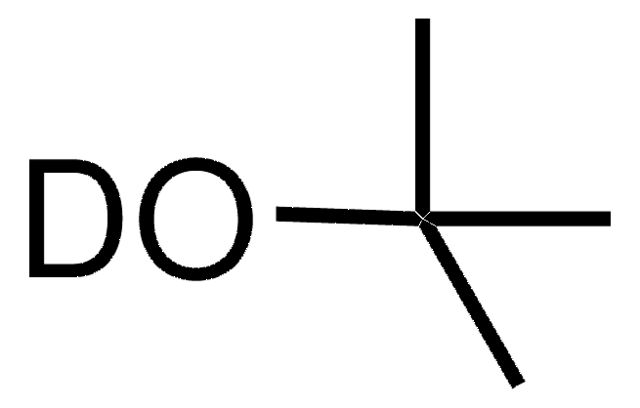50621
tert-Butanol
analytical standard
Synonym(s):
2-Methyl-2-propanol, tert-Butyl alcohol, Trimethyl carbinol
About This Item
Recommended Products
grade
analytical standard
Quality Level
vapor density
2.5 (vs air)
vapor pressure
31 mmHg ( 20 °C)
44 mmHg ( 26 °C)
Assay
≥99.8% (GC)
autoignition temp.
896 °F
shelf life
limited shelf life, expiry date on the label
expl. lim.
8 %
technique(s)
HPLC: suitable
gas chromatography (GC): suitable
refractive index
n20/D 1.387 (lit.)
n20/D 1.387
bp
83 °C (lit.)
mp
23-26 °C (lit.)
density
0.775 g/mL at 25 °C (lit.)
application(s)
cleaning products
cosmetics
environmental
flavors and fragrances
food and beverages
personal care
format
neat
SMILES string
CC(C)(C)O
InChI
1S/C4H10O/c1-4(2,3)5/h5H,1-3H3
InChI key
DKGAVHZHDRPRBM-UHFFFAOYSA-N
Looking for similar products? Visit Product Comparison Guide
General description
Application
- Detection and quantification of butanol and its isomers in paint samples by a rapid fast gas chromatography-proton transfer reaction-mass spectrometer (FastGC-PTR-MS) method
- Simultaneous assessment of 121 VOCs emitted from 41 cellulose acetate movie films by proton transfer reaction-time-of-flight-mass spectrometry (PTR-ToF-MS)
- As an internal standard in the determination of n-butane and its metabolites in the blood, heart, and tissue samples of three autopsy cases that died due to sniffling n-butane and isobutane from portable gas cartridges
- Headspace-single drop microextraction (HS-SDME) of VOCs from different types of tomato samples for their quantification by gas chromatography-flame ionization detection (GC-FID)
Other Notes
Recommended products
Signal Word
Danger
Hazard Statements
Precautionary Statements
Hazard Classifications
Acute Tox. 4 Inhalation - Eye Irrit. 2 - Flam. Liq. 2 - STOT SE 3
Target Organs
Central nervous system, Respiratory system
Storage Class Code
3 - Flammable liquids
WGK
WGK 1
Flash Point(F)
59.0 °F - closed cup
Flash Point(C)
15 °C - closed cup
Personal Protective Equipment
Choose from one of the most recent versions:
Already Own This Product?
Find documentation for the products that you have recently purchased in the Document Library.
Customers Also Viewed
Articles
Learn about analyzing organic volatile impurities (OVIs) in pharmaceuticals using SH-GC, focusing on suitable solvents and ensuring compliance.
Our team of scientists has experience in all areas of research including Life Science, Material Science, Chemical Synthesis, Chromatography, Analytical and many others.
Contact Technical Service












